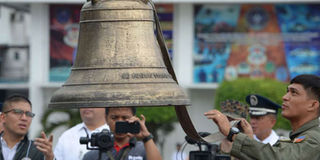US returns war trophy bells to Philippines

Philippine military personnel unload one of the three Balangiga church bells shortly after it arrived from the US at a military airbase in Manila on December 11, 2018. PHOTO | TED ALJIBE | AFP
What you need to know:
- The bells were said to have signalled a surprise attack by machete-wielding Filipino revolutionaries that killed 48 US troops on September 28, 1901 in Balangiga.
- Thousands of Filipinos were slaughtered, the town was razed and the bells were carted off as trophies.
- Two had been on display at a US air base in Wyoming and the other in South Korea.
Church bells seized from the Philippines by the US as war trophies over a century ago were returned on Tuesday, in a bid to turn the page on a difficult chapter between the historical allies.
Returning the three so-called Balangiga bells meets a decades-old demand from the former US colony at a time when the two nations' ties have been rattled by President Rodrigo Duterte's pivot to China.
An American military plane delivered the bells to a Manila airfield, where Philippine and American officials gathered ahead of a symbolic handover ceremony.
The bells were said to have signalled a surprise attack by machete-wielding Filipino revolutionaries that killed 48 US troops on September 28, 1901 in the central town of Balangiga.
In reprisal, the US commander Jacob Smith ordered the surrounding island of Samar be turned into a "howling wilderness" and that all Filipino males aged 10 or above be killed.
'PAINFUL CHAPTER'
Thousands of Filipinos were slaughtered, the town was razed and the bells were carted off as trophies. Two had been on display at a US air base in Wyoming and the other in South Korea.
The return of the bells has been divisive with some US veterans and lawmakers, who see them as a tribute to fallen American troops while the Philippines hails them as a symbol of its struggle for independence.
American officials have emphasised the return is an important step in closing a painful chapter between the two nations, which have close military, cultural and trade ties.
Manila's push for the bells' repatriation began in the 1990s and has had backing from Philippine presidents as well as from the Catholic Church and historians.
Duterte, 73, bluntly called on Washington in a 2017 speech to "Give us back those Balangiga bells. They are not yours," as he rattled his nation's close alliance with the US.
Within months of winning the presidency in mid-2016 he signalled his intention to split from the Philippines' former colonial master and end a standoff with Beijing over the disputed South China Sea.
Duterte's supporters have claimed his willingness to stand up to American influence was key to the bells' return, but experts cautioned the process was much more complicated.
"No single president can claim credit to it," Francis Gealogo, history professor at the Ateneo de Manila University, told AFP. "The credit should be given to the Filipino people who campaigned vigorously and actively."
A key factor was also major American veterans' associations, including the largest group Veterans of Foreign Wars, dropping their opposition to the bells being given back.
"The return of the bells would be 'the right thing to do'", said a resolution the group approved in July calling on the US government to return them.





